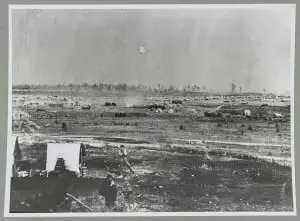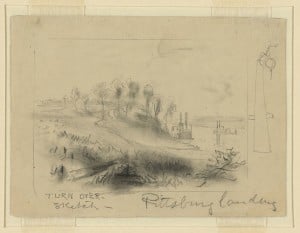April 6th – 7th 1862
The Battle of Shiloh also known as the Battle of Pittsburg Landing was one of the bloodiest battles during the entire Civil War.
It took place in the western theater of the Civil War in Tennessee. The Union army was on the offensive and their goal was to capture Corinth Mississippi which was a vital railroad and communication center for the Confederacy.
There were two Union armies the Confederates needed to deal with.
The first had 40,000 soldiers commanded by General Ulysses S. Grant and the second army consisted of 20,000 soldiers commanded by General Don Carlos Buell.
Grant and his army waited at Pittsburg Landing Tennessee as General Buell’s army marched to link up with them. The Confederate army which numbered 44,000 soldiers was commanded by General Albert Sidney Johnston.
After the Confederates were defeated at Fort Henry and Fort Donelson Confederate General Albert Sidney Johnston gathered his scattered rebel forces in Corinth to protect the region from Union attack.
Instead of waiting for the inevitable attack General Johnston decided to go on the offensive and attack General Grant’s army waiting at Pittsburg Landing, Tennessee.
Battle of Shiloh – The First Day
On Sunday April 6th 1862 a little after 7:00am General William T. Sherman who commanded a division of Grant’s army rode out into a field with his staff officers in front of their lines.
Confederate pickets hiding across from this field along a small stream watched General Sherman and his staff as they surveyed the area. This small group of Confederates opened fire on Sherman and his staff killing Sherman’s orderly Thomas D. Holliday. General Sherman and his staff quickly retreated back to their lines.
An hour later at 8:00am General Sherman looked across that same field and saw a sea of glistening bayonets. He realized that those few Confederate troops that fired on him had now turned into a mass of Confederate infantry waiting along the small stream poised for an attack across his entire front.
Confederate artillery opened fire and Union artillery returned fire starting the Battle of Shiloh. Confederate infantry soon began advancing onto Sherman’s division, the rebels also attacked General Prentiss’s and General McClernand’s divisions. General Prentiss and his men were quickly forced back.
Union Major General John McClernand commanding the First Division with 7,028 men under his command reported a large mass of Confederate troops five regiments deep carrying a United States flag as they marched toward his division. They did this in order to fool Union commanders into thinking they were friendly troops.
The Confederate attack succeeded in pushing the entire Union front back almost to Pittsburg Landing itself. Confederate general Albert Sidney Johnston was leading an attack on horseback, he was hit behind his knee. He did not think the wound was severe so he stayed in his saddle and continued to lead his men.
He eventually fainted in his saddle, he was taken from the field for medical treatment, unfortunately his men could not find where he had been wounded, eventually they noticed his boot was filled with blood and they discovered he had been hit behind his knee. He died only a few moments later.
Albert Sidney Johnston’s death at Shiloh was a huge blow to his men and the Confederacy. He was beloved and respected by his men so his loss was one that was felt by every soldier he commanded.
Confederate General P.G.T. Beauregard who was second in command of Confederate forces immediately assumed command after Johnston’s death.
The Confederate attacks toward Pittsburg Landing eventually began to run out of steam, the Union army formed a defensive line aided by two Union gunboats the Tyler and Lexington who were guarding Pittsburg Landing and shelled Confederate forces as they attempted to turn the Union flank and capture the landing.
General Sherman and General McClernand were able to solidify the front line and hold the Confederate attacks for four hours. At about 4:00pm the two generals decided they needed to fall back some more since other nearby troops were beginning to lose ground. They setup a new position gathering up any scattered forces they came across.
After forming this new line General McClernand made a small counterattack pushing the Confederate forces back into a ravine in from of the Union line. Roughly 200 yards separated the two armies as the fighting ended for the day.
That night Union General Don Carlos Buell arrived with his army to reinforce the army fighting at Shiloh. This brought the total number of Union soldiers at Shiloh to 54,500 men. The Union army now outnumbered the Confederates at Shiloh who only had 34,000 soldiers left.
It rained heavily during the entire night making for a miserable experience on both sides.
After the first day Confederate General Beauregard was so pleased with the performance of his army that he believed they had achieved a great victory over the Union at Shiloh. He sent off a dispatch proclaiming victory saying the enemy had been driven from every position and that they had achieved a complete victory. He planned on finishing off the Union army the following day.
He clearly had no idea what the next day would bring.
Battle of Shiloh – The Second Day
The next day April 7th General Ulysses S. Grant ordered a counterattack to retake everything that was lost the day before.
The Union began a major counterattack all along the line driving the Confederates back gradually until they began a full retreat. The fighting was very tough as the Confederates tenaciously tried to hold onto the ground they had gained the day before.
The Union was too strong with fresh reinforcements from General Buell’s army. The Confederates were extremely tired from the heavy fighting the previous day. They began, slowly at first to be pushed back by the Federal army and by late afternoon they were in full retreat.
At 4:00pm the Union had pushed the rebels back so far that they were now on their original front line where the battle started the day before.
The Confederate army retreated back to Corinth, Mississippi.
The battle of Shiloh was over. General Ulysses S. Grant and the Union army had won a major victory in the western theater. Total casualties for both sides was 23,746 soldiers killed, wounded, and captured.
































